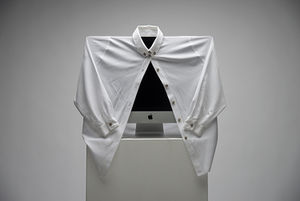How To Be More Or Less Human: Difference between revisions
No edit summary |
No edit summary |
||
| (6 intermediate revisions by 2 users not shown) | |||
| Line 2: | Line 2: | ||
|Creator=Max Dovey | |Creator=Max Dovey | ||
|Date=2015 | |Date=2015 | ||
|Bio= Max Dovey [UK] is 28.3% man, 14.1% artist and 8.4% successful. His performances confront how computers, software, and data affect the human condition. Specifically he is interested in how the meritocracy of neo-liberal ideology is embedded in technology and digital culture. His research is in “liveness” and real-time computation in performance and theatre. | |Bio=Max Dovey [UK] is 28.3% man, 14.1% artist and 8.4% successful. His performances confront how computers, software, and data affect the human condition. Specifically he is interested in how the meritocracy of neo-liberal ideology is embedded in technology and digital culture. His research is in “liveness” and real-time computation in performance and theatre. | ||
|Thumbnail=Howtobemoreorless_thumbnail.jpg | |Thumbnail=Howtobemoreorless_thumbnail.jpg | ||
|Website=http://howtobemoreorless.com | |Website=http://howtobemoreorless.com | ||
|Description=How To Be More Or Less Human investigates how human activity is classified by image recognition software. Computer vision and the gaze of the webcam become the basis for a performance that explores how online databases form an identity of the human subject. Performances will take place every hour during the opening on 3 July and by appointment during the exhibition. | |||
|Description=How To Be More Or Less Human investigates how human activity is classified by image recognition software. Computer vision and the gaze of the webcam become the basis for a performance that explores how online databases form an identity of the human subject. | |Catalog-Text1= [[http://pzwiki.wdka.nl/mw-mediadesign/images/7/72/Maxcataloguepg1.pdf]] | ||
|Catalog-Text2= [[http://pzwiki.wdka.nl/mw-mediadesign/images/7/7e/Maxcatalougepg2.pdf]] | |||
Performances will take place every hour during the opening on 3 July and by appointment during the exhibition. | |||
|Catalog-Text1= [[ | |||
|Catalog-Text2= | |||
|Catalog-Text3= | |Catalog-Text3= | ||
Hello, | Hello, | ||
| Line 59: | Line 56: | ||
}} | }} | ||
<gallery> | |||
File:Howtobemoreorless_thumbnail.jpg | |||
</gallery> | |||
How To Be More Or Less Human investigates how human activity is classified by image recognition software. Computer vision and the gaze of the webcam become the basis for a performance that explores how online databases form an identity of the human subject. A clinic is divided by two computers that continually project words from an image recognition program. A man enters at appointed times and performs a series of actions that are analysed by the image recognition software. The confidence levels of the image recognition program become the basis for a performance between a man and an algorithm. | |||
How To Be More Or Less Human examines how computer vision classifies gender, race and class through commercial stock imagery. Visual stereotypes and typologies are highlighted and performed by human and non-human actors to demonstrate how humans are encoded into computer vision. | |||
How To Be More Or Less Human | |||
Latest revision as of 16:23, 13 February 2017
| How To Be More Or Less Human | |
|---|---|
| Creator | Max Dovey |
| Year | 2015 |
| Bio | Max Dovey [UK] is 28.3% man, 14.1% artist and 8.4% successful. His performances confront how computers, software, and data affect the human condition. Specifically he is interested in how the meritocracy of neo-liberal ideology is embedded in technology and digital culture. His research is in “liveness” and real-time computation in performance and theatre. |
| Thumbnail | |
| Website | http://howtobemoreorless.com |
How To Be More Or Less Human investigates how human activity is classified by image recognition software. Computer vision and the gaze of the webcam become the basis for a performance that explores how online databases form an identity of the human subject. Performances will take place every hour during the opening on 3 July and by appointment during the exhibition.
How To Be More Or Less Human investigates how human activity is classified by image recognition software. Computer vision and the gaze of the webcam become the basis for a performance that explores how online databases form an identity of the human subject. A clinic is divided by two computers that continually project words from an image recognition program. A man enters at appointed times and performs a series of actions that are analysed by the image recognition software. The confidence levels of the image recognition program become the basis for a performance between a man and an algorithm. How To Be More Or Less Human examines how computer vision classifies gender, race and class through commercial stock imagery. Visual stereotypes and typologies are highlighted and performed by human and non-human actors to demonstrate how humans are encoded into computer vision.


